![]()
![]()
On September 10, 2001, we recorded interesting facts about our class that were displayed in 64 bar graphs and Venn Diagrams in our room.
![]()
| When | Who | From Where | Journey | Why |
|---|---|---|---|---|
| 1906 | Anna-Rose | Kumamoto, Japan | Boat, 6 weeks | arranged marriage |
| 20 Years Later | ||||
| 1926 | Ms. Surber | West Brook, Texas | Truck, 3 years | good farmland |
| 8 Years Later | ||||
| 1934 | Eben | Harrison, New York | Train, 3 days | job at Stanford University |
| 17 Years Later | ||||
| 1951 | Neulyn | Detroit, Michigan | Plane, 5 hours | warm climate |
| 4 Years Later | ||||
| 1955 | Russell | Boston, Massachussets | Car, 3 weeks | job as doctor |
| 5 Years Later | ||||
| 1960 | Richard | Austin, Texas | Plane, 4 hours | good climate |
| 2 Years Later | ||||
| 1962 | Jordan | Chicago, Illinois | Plane, 4 hours | new job |
| 4 Years Later | ||||
| 1966 | Jasper | Weatogue, Connecticut | Car, 1 week | health, warmer climate |
| 1967 | Jack | Frostburg, Maryland | Plane, 8 hours | Stanford University |
| 7 Years Later | ||||
| 1974 | Kyle | Baltimore, Maryland | Car, 1 week | job at Stanford |
| 6 Years Later | ||||
| 1980 | Maren Ryan | Philippines South Bend, Indiana | Plane, 18 hours Plane, 6 hours | better job job |
| 1981 | Stephanie | Quinhon, Vietnam | Boat & plane, 10 days | escape Communists & good weather |
| 2 Years Later | ||||
| 1984 | Natasha | Henderson, Nebraska | Car, 5 days | marriage & job |
| 1985 | Lydia | Guanajuato, México | Van, 1 month | good environment |
| 3 Years Later | ||||
| 1988 | Pratul | West Lafayette, Indiana | Train, 4 days | job |
| 2 Years Later | ||||
| 1990 | Amanda Dane | Dallas, Texas Atlanta, Georgia | Plane, 6 hours Plane, 6 hours | new job Navy |
| 3 Years Later | ||||
| 1993 | Julio | México | Bus, 10 hours | job |
| 1994 | Henry | Libertyville, Illinois | Plane, 4 hours | start biotech division |
| 1995 | Toshiya | Sendai, Japan | Train & plane, 13 hours | job at Stanford University |
| 1996 | Sierra | Tucson, Arizona | Car, 2 days | graduate school |
| 3 Years Later | ||||
| 1999 | Ben | Welsely, Massachussets | Plane, 4 hours | new job |
| 2000 | Adam Alejandra Marilyn Oana Ori Timothy William | Albany, New York Arequipa, Peru Bogotá, Colombia Toronto, Canada (via Romania) Tel Aviv, Israel Allentown, Pennsylvania San Salvador, El Salvador | Plane, 6 hours Plane, 10 hours Plane, 12 hours Plane, 3 months Plane, 24 hours Plane, 7 hours Bus & plane, 1 month | better schools beautiful place special doctor new job job job good place to live |
![]()
Pairs of students in our class created portraits of aliens and wrote descriptions of the aliens. Students in our partner class at Escondido attempted to re-create our aliens after reading our descriptions while we did the same for theirs. Then we compared the original alien portraits with the recreations and evaluated our descriptions. Visit our Aliens webpages to try see the results.
![]()
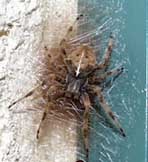
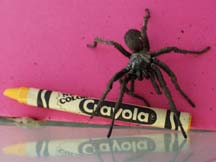 We captured our first spider (pictured on the left) in front of our classroom on October 24th. We think it was a wolf spider, and we know it was BIG! It dug a hole under its water dish and liked to hide out during the day. We released our wolf spider back into the wild on November 1st. It looked even BIGGER out of the cage!
We captured our first spider (pictured on the left) in front of our classroom on October 24th. We think it was a wolf spider, and we know it was BIG! It dug a hole under its water dish and liked to hide out during the day. We released our wolf spider back into the wild on November 1st. It looked even BIGGER out of the cage!
Our second spider (pictured on the right) attached her egg case right outside our back door on November 13th. It took her about a day to firmly attach the egg case with many many many silken threads. She sits on top of the web guarding her egg case. We don’t know if there are 514 eggs (like Charlotte) or what kind of spider it is. We hope that the distinctive white arrow shape and the two horn like points on the abdomen will help us figure our what kind it is. It is another BIG spider! On December 3rd we noticed that the spider looked flatter and thinner. On December 7th the spider had vanished, but the egg case is still there.
![]()

Francisco awarded the Golden Trash Can to classrooms with the cleanest lunch tables. We first won the award on December 1st. Our longest streak was 22 Golden Trash Cans in a row!
![]()
We joined classrooms all across North America in a telecommunication project to track the progress of spring by observing the emergence of tulips. 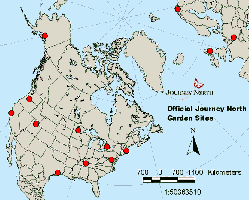 Our class has been selected as one of the 13 Official Journey North Tulip Gardens. Our first activity was predicting what order the 13 Official Tulip Gardens would bloom. Our class prediction:
Our class has been selected as one of the 13 Official Journey North Tulip Gardens. Our first activity was predicting what order the 13 Official Tulip Gardens would bloom. Our class prediction:

Each student measured the circumference of a tulip bulb, weighed it, and then predicted when that bulb would emerge and bloom in relation to the rest of the class bulbs. We made sketches of our bulbs and learned about the parts of the bulb. We cut the extra bulbs in half and sketched the internal structure of the tulip bulbs. We discovered that the tulip bulbs are made of many layers surrounding the bloom bud. We planted our bulbs on December 7th with a little stick to mark the placement of each bulb in our new planter box. On February 20th, We returned from a long weekend to find that our tulips had emerged; we are mentioned in the February 22nd data report. You can track the progress of spring (measured by the blooming tulips) by looking at the weekly maps. Our first tulips bloomed finally bloomed on March 14th and are featured in the March 22nd Report. We enjoyed the blooms for weeks, both in the sun and in the rain.
![]()
We started collecting data about Matadero Creek in March. You can learn more by visiting our Matadera Creek Data page.
![]()
California Relief Maps: We sketched the major geographical features on large boards and modeled the mountains and valleys. After the "goop" dries, we will paint the elevations and the surrounding states. Finally we located five important cities and made a key. We agreed that this was a fun and messy project! The finished maps are quite impressive.
Investigating Artifacts: In the first section of this unit we walked to Bol Park to collect natural materials which we sorted and classified and then used for a math lesson on Venn Diagrams. It was fun trying to guess the Secret Sorting Rule of each Venn Diagram. Then we made masks (more masks). In the second section we listened to myths, wrote our own myths, created posters (more posters) to illustrate the myths, and shared our myths around a “campfire” in the Library. In the final section of the unit we excavated “middens” by carefully sieving the soil, cleaning and polishing the artifacts, and recording the spot where each artifact was discovered. The completed midden maps (another map) and museums (another museum) helped us draw inferences about the culture from the artifacts we found.
California Explorers: Each group chose an explorer who was important in the history of California. Students made timelines of California and placed their explorers in time, made maps to show where the explorers traveled, drew portraits of what the explorers might have looked like, and wrote essays about the goals and accomplishments of the explorers. Then each group created a poster and made a presentation to the rest of the class. Explorers we learned about:
Mission Period: Each student chose one of the 21 California Missions as the topic of a research report. We learned how the Spanish changed the lives of the Native Californians and wrote letters from the perspective of a Native American who had joined a mission. Our final project was creating a HyperStudio stack to publish our reports.
Gold Rush: The Room 17 Gold Rush was a great success! Our miners struck it rich at the Barron Park Gold fields and then spent most of their money in our gold rush town. Cha Cha‚s Gold Claims Assay Office was efficient and well organized. The Bear Bank did a booming business buying gold from the miners for $16.00 an ounce. Our hungry and thirsty miners didn't mind the high prices at The Gold Rush Café, there was a good selection of goods at the Hangtown General Store, and the show performed by Cha Cha’s Golden Entertainment & Comedians was the best show in town.
![]()
Our first math unit was “All About Us,” an introductory statistics and graphing unit. We learned all sorts of interesting things about our class and organized our data with bar graphs and Venn Diagrams. We finished our second math unit, “Mathematical Thinking in 4th Grade,” by creating symmetrical designs. Some designs had both mirror and rotational symmetry (Two Mirror and Rotational Designs & Two More Mirror and Rotational Designs). It was harder to make designs that had rotational symmetry, but not mirror symmetry (Two Rotational Symmetry Designs & Two More Rotational Symmetry Designs). In our third math unit, “Arrays and Shares,” we practiced our multiplication facts through 12x12 and worked on multiplication and division problems. In the “Landmarks in the Thousands,” unit we investigated our number system by working with problems in the 100s and 1000s. The final activity for this unit was making a 10,000 chart, which was huge! Our fifth math unit was “Area and Perimeter.“ We figured the area and perimeter of our feet, discovered the different perimeters possible for one area and the different areas possible for one perimeter. The final activity for this unit was creating a zoo habitat and figuring the area and perimeter. In “Equal Shares, Different Pieces,” we explored fractions. In “Money, Miles, and Large Numbers” we worked with decimal numbers. The final project for this unit was to figure out how to measure a quarter of a mile. In the “Packages and Groups” unit we practiced multiplication and division with two and three digit numbers. Our Data and Statistics unit was “The Shape of the Data.” In this unit we collected and organized data and learned about statistics. We collected data about our families, compared the heights of 1st and 4th graders, and investigated sleep patterns. The range of our school night sleep was 6 to 11 1/2 hours; the range of our weekend sleep was 5 1/2 hours to 10 1/2 hours.
![]()
Island of the Blue Dolphins, by Scott O’Dell, helped us understand the life of the Chumash. We illustrated our favorite parts of the book captioned with a quote from the novel (two examples and two more examples). We wrote poems using similes (a favorite literary device of Scott O’Dell) and created crayon and water color art projects featuring organisms from the book (four watercolors and four more watercolors). For our final activity we watched the movie adaptation of the book and discussed the similarities and differences.
Babe, the Gallant Pig, by Dick King-Smith, was fun to read even though the dialect was often difficult to understand. We learned many new vocabulary words about sheep herding and discovered how being brave and polite can lead to success. The final activity for this book was to create ribbons (two examples & two more) summarizing how each character helped Babe achieve his goal.
Literature Circles: Here are culminating activities for some of the books we have read.
![]()
Water: Our first science unit is the study of water. We have observed several properties of water: surface tension, rate of flow, and expansion/contraction with changes in temperature. We also investigated how location and surface area influence the rate of evaporation and explored condensation. Using a chemical indicator, we tested to see if water samples were hard or soft. We investigated what happens when water flows over different Earth materials and tested water from home. The final activity of our study of Water was a Water Taste Test comparing five different types of water.
Magnetism & Electricity: In this unit we experimented with magnetism, conductivity, series and parallel circuits, and electromagnets. The final activity of our study of Magnetism & Electricity was for pairs of students to chose a questions and design an experiment to investigate the question.
 Animal Studies: In this life science unit we observed and cared for Dwarf African Frogs, Fiddler Crabs, and Land Snails for five weeks. We learned many interesting things by watching our animals and learning to take accurate observational notes. The final activity was a group project to investigate a question about our animals.
Animal Studies: In this life science unit we observed and cared for Dwarf African Frogs, Fiddler Crabs, and Land Snails for five weeks. We learned many interesting things by watching our animals and learning to take accurate observational notes. The final activity was a group project to investigate a question about our animals.
![]()
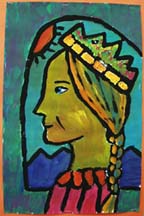
Chimes: In Music we learned to play the chimes to make chords while playing the blues.
Explorer Portraits: We learned to make portraits while studying explorers. Here are two portraits of Álvar Nuñez Cabeza de Vaca, two portraits of Juan Rodríguez Cabrillo, and portraits of Gaspar de Portola and Hernán Cortés.
Rouault Court: We made self portraits in the style of Georges Rouault, who was a stained glass artist before becoming a painter.
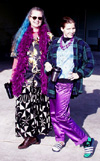 Crazy Clothes Day: On December 12th there were some very silly looking outfits at Barron Park!
Crazy Clothes Day: On December 12th there were some very silly looking outfits at Barron Park!
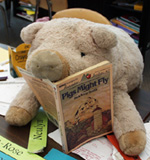 Stuffed Animal Day: January 24th was Stuffed Animal Day. We graphed the 62 animals visiting in our room by type, color, size, number per person, and species. We discovered that about 2/3 of our class brought animals, most of the stuffed animals were mammals, bears and dogs were the most numerous, about half were mixed colors, most were small or medium sized, and one pig liked to read! Here are the animals for each seating group:
Stuffed Animal Day: January 24th was Stuffed Animal Day. We graphed the 62 animals visiting in our room by type, color, size, number per person, and species. We discovered that about 2/3 of our class brought animals, most of the stuffed animals were mammals, bears and dogs were the most numerous, about half were mixed colors, most were small or medium sized, and one pig liked to read! Here are the animals for each seating group:
100th Day of School Theme Day: February 11th was the 100th day of school. We solved problems about 100 for math and had a list of 100s challenges to choose from. Jordan wore 100 black beads, Dane wore 100 letters on the tag of his shirt, Neulyn wore a necklace with 100 shells, and Ms. Surber wore 100 cowboy boots. Ori ate 100 Fruit Loops, Alejandra ate 100 spaghettis, Eben ate 100 pieces of licorice, Tim drank 100 sips of water, Pratul ate 100 chocolates, Jordan ate 100 goldfish, Dane ate 100 marshmallows, and Ms. Surber ate 100 curds of cottage cheese. And Ben, Natasha, Adam, Ryan, Pratul and Ms. Surber attended school for every single one of the first 100 days!
Read Across America and Pajama Day: On March 1st we celebrated reading by reading to ourselves and each other for most of the day. We rearranged our classroom so that we could lounge comfortably in our pajamas while reading.
![]()
Website for Ms. Surber’s Current Class
Copyright © 1998-2004 Lucinda Surber. All Rights Reserved.